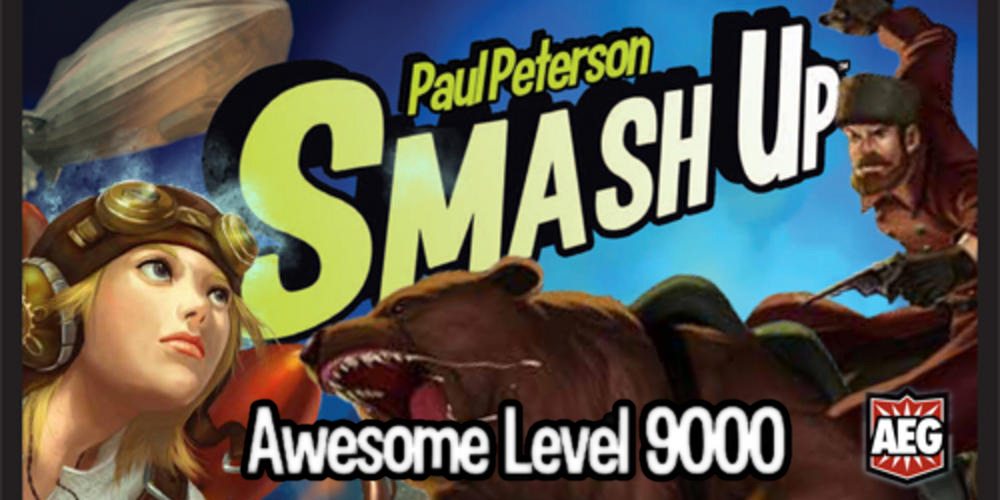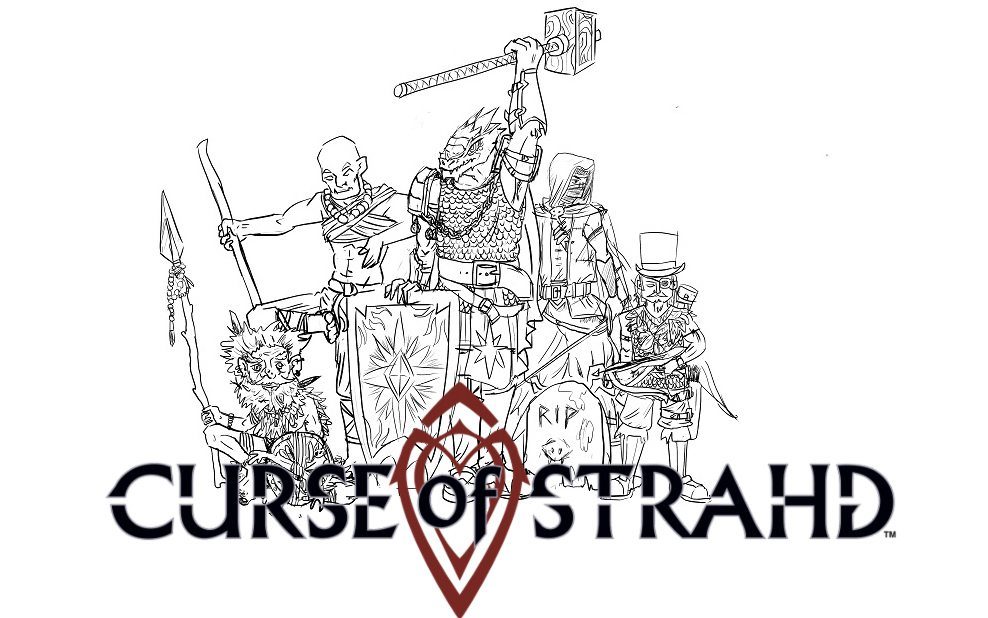
You may have seen Wil Wheaton & Co. playing Smash Up on TableTop last month–it’s a “shuffle-building” game that’s got a good deal of humor. You get to choose two factions from a list that includes robots, dinosaurs, ninjas, and pirates, and then battle to take over bases.
 The original game launched at Gen Con 2012 and sold out its first run quite quickly. This year AEG introduced the first (stand-alone) expansion, Awesome Level 9000, and the Obligatory Cthulhu Set is expected in September.
The original game launched at Gen Con 2012 and sold out its first run quite quickly. This year AEG introduced the first (stand-alone) expansion, Awesome Level 9000, and the Obligatory Cthulhu Set is expected in September.
Here’s an recap of how the core game works, plus a little more about what’s so awesome about Awesome Level 9000, which also functions as a stand-alone game for 2 players. The Smash Up core set is for 2 to 4 players and is recommended for ages 12 and up, although kids younger than that will probably be able to handle the gameplay and subject matter. The main requirement is being able to read, because there’s a lot of text involved. It takes about 45 minutes to play. The core set retails for $29.99, and the expansions retail for $19.99 each.

So here’s the story: the various factions are all interested in taking over the world–but none of them can do it alone, so they’ve decided to team up. Each one has its own unique strengths, which correspond to the gameplay: Zombies come back from the dead (i.e., the discard pile); Ninjas are sneaky and can slip onto a base at the last moment; Aliens can beam up minions, sending them back to a player’s hand. The game has a lot of humor built in (the dinosaurs, for instance, have laser guns and other futuristic tech) and the illustrations are terrific.
What’s inside:
The cards are pretty standard size and quality. They’re really easy to read: Minions have a big strength number in the corner and say “Minion,” and Action cards say “Action” with a description. Each faction has its own icon in the bottom corner, as well as its own typeface and background color, making them easy to separate out at the end of a game.
The core set comes with 8 factions with 20 cards each, and 16 base cards. The expansions come with 4 factions each and 8 new base cards–but they also include the 16 original base cards so that even if you only have the expansion you get a wider variety of bases to attack. The expansions also include a sheet of victory point tokens–something that wasn’t provided in the core.
Unfortunately, the extra-large base cards on TableTop were specially made for the show; your copy of the game will just have standard card-sized bases, and you’ll have to figure your own methods of keeping track of who cards belong to and what the total attack power is.
If you look at the photo up at the top, you can see that the nine decks of cards hardly take up all of the space in that large square box. There’s a big plastic divider included, and these cards take up half of them — clearly there’s room built in for expansions (or for two sets of Smash Up, in case two players really want to be Ninjas).
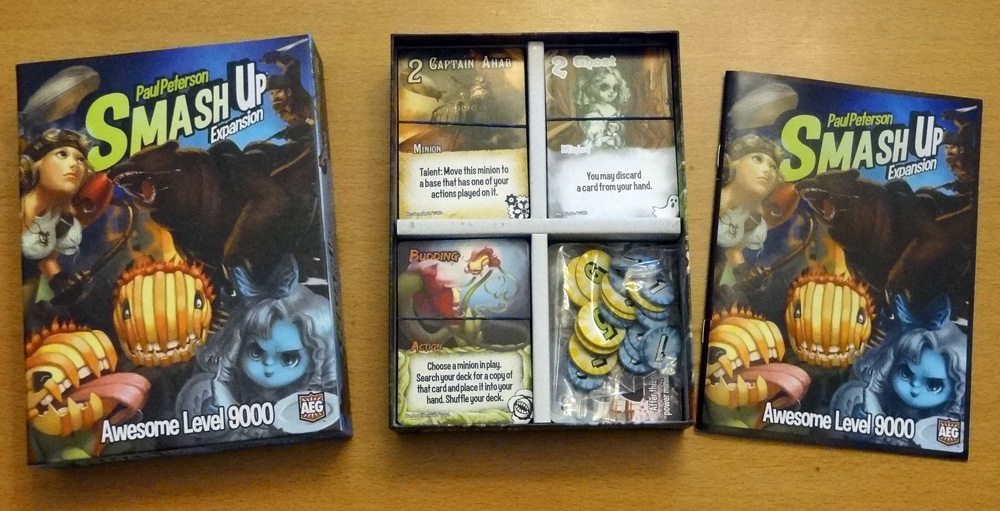
The expansion, though, comes in a much smaller box–and although the cardboard divider doesn’t really keep the cards separate (unless you use rubber bands), it’s plenty big enough to hold the original game and the expansion, so I’m using this box for portability now.
You’ll need something (tokens, pen and paper, smartphone app) to keep track of score.
One thing I should mention: if you’re a rules lawyer, you’ll appreciate the wording on the cards, because they mean what they say. If the card only affects other players, it will say so. If a card says “on this base” then it affects that base — if it doesn’t say that, then it affects everywhere. Careful reading of the cards will tell you what they do and don’t do, and the benefits of having clearly-stated cards should not be underestimated.
Here’s a list of all of the factions and what they do:
Core Set:
- Pirates move cards around the table
- Ninja are sneaky and can be added for last minute victories
- Zombies come back from the discard pile
- Robots are small but numerous
- Dinosaurs are just plain big–and they have lasers
- Wizards get to pull a lot of cards from the deck
- Tricksters mess with the other players
- Aliens move enemies around and affect the Bases themselves
Awesome Level 9000:
- Killer Plants start off small, but they can get much bigger
- Ghosts benefit from having fewer cards in your hand
- Steampunks can modify bases to give you a better attack
- Bear Cavalry scare away your enemies–or just plain destroy them
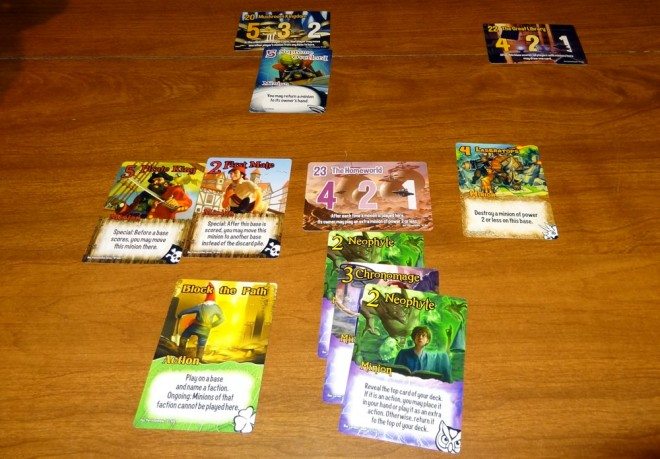
How to Play:
At the beginning of play, the eight faction decks are set out, and each player chooses two and shuffles them together. (Starting player chooses one faction first, and when everyone has chosen one faction, then last player gets to choose a second faction and it goes in reverse order.) The base cards are shuffled together and three are turned face up on the table. Each player draws five cards from their deck. The goal of the game is to get 15 victory points first.
Basic turn order: You can play up to one minion and one action, in either order, or play no cards at all. After playing cards, you check if any of the bases score, and award victory points. Finally, you draw two cards and then discard down to a ten card hand limit.
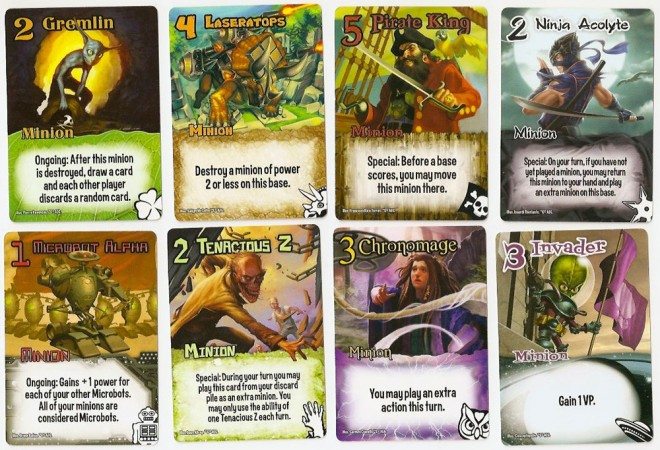
Playing cards: Minions are played next to one of the three bases, and then you follow the instructions on the card to activate the minion’s ability. To play an action, you show the card, follow the directions, and then discard it (unless it says “ongoing”).
Scoring bases: If the total power of the minions on a base meets or exceeds the base’s breakpoint (the number in the top corner), then the base has been destroyed and is scored. The player with the most points gets the first place points (the big number on the left); the second place gets the middle number, and the third place gets the number on the right. You must have at least one minion on the base to get points. After any special abilities are taken into account (sometimes you can move minions to other bases or put them back into your hand) then the base and all cards attached to it are discarded, and a new base is drawn to replace the old one.

Of course, the special abilities are what make the game really interesting. Just about every minion has some ability attached to it: some let you destroy other minions, draw or play extra cards, or protect yourself from attacks. The action cards are also varied, and each faction has different types of powers.
Aliens can beam minions back to their owner’s hand, and can swap out bases. Dinosaurs have a lot of strength; Robots, meanwhile, have strength in numbers with lots and lots of small minions. Ninjas are sneaky, with several cards that can add or swap out minions on a base just before it scores. Pirates can move around from base to base. Tricksters have some really nasty tricks that prevent you from destroying their minions. Wizards tend to play a lot of extra actions and get more cards. And finally, Zombies can pull stuff out of the discard pile to send minions in waves. And, of course, you’ll each have two of these factions, so there are some really interesting combinations of effects.
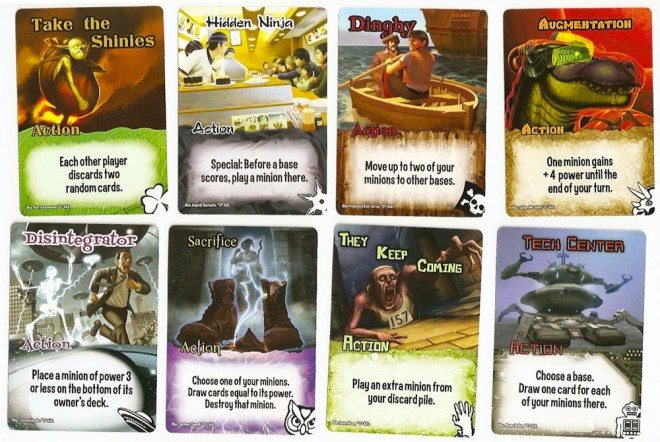
The Verdict:
Smash Up feels a little like a departure from the games AEG is best-known for, like Legend of the Five Rings and Thunderstone. It’s a lot more chaotic and definitely doesn’t take itself too seriously, which is a refreshing change of pace (as much as I love Thunderstone). Your strategy depends on both your particular combination of cards and your opponents’ factions, so it is different each time. There are 28 possible combinations (with the core set), and throwing in the expansion adds even more fun–Plants vs. Zombies, anyone? However, I wouldn’t say that any combination of two factions is equally strong–there are certainly some combinations that work better than others.
But if you’re trying to analyze all the decks to come up with the perfect strategy, then you’re kind of missing the point. Sure, you want to beat the other players into submission–but mostly Smash Up is a game of funny references and “take that!” moments. It’s not quite as chaotic as Fluxx, but it’s also meant to be light-hearted and fast-paced. The “shufflebuilding” mechanic turns Magic-style deck-building on its head, getting your “custom” deck set up and ready to play in a fraction of the time.
While the game is recommended for ages twelve and up, I think any player who can read and add up powers (mind the modifiers!) could handle the gameplay, and the subject matter shouldn’t bother most younger kids (except maybe the zombies). The main limiting factor would be whether your kids can handle the back-stabbing and direct conflict, because there’s a lot of that–you’ll destroy each other’s minions, mess with other people’s cards, and so on. But if they’re not sore losers, then Smash Up could be a lot of fun with your younger kids, too.
I really love the artwork on the cards. Each faction was illustrated by a different artist, giving them their own distinct flavors, but there’s a sense of humor underlying it all that ties them together. I’m slightly peeved at the size of the box of the core set, so I’m pleased that the expansion gives me a box I can travel with.
I’ve really enjoyed the new factions in Awesome Level 9000. If you already own Smash Up and enjoy it, the expansion is worth picking up, though I don’t know that the four factions would provide enough replayability on its own. The added scoring tokens are nice, since with the core game you had to just provide your own scorekeeping mechanics.
In the end, Smash Up is the sort of game you can probably tell just from the cover whether you’ll like it or not. From the name to the tagline to the artwork, if you’re drawn to this sort of thing, you’ll agree that it’s a game of “total awesomeness.” If the cover turns you off, then the contents of the box probably won’t change your mind.
Disclosure: GeekDad received a review copy of this game.
